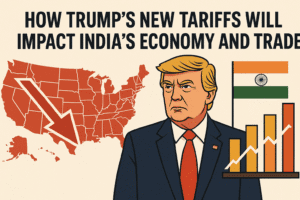How Trump’s New Tariffs Will Impact India’s Economy and Trade
U.S. President Trump’s imposition of 25% tariffs on Indian imports, plus an unspecified penalty, targets India’s trade barriers and its energy/defense dealings with Russia. While the overall GDP impact is projected at a modest 0.2% reduction, specific export sectors face significant pressure: textiles, gems & jewelry, auto parts, and leather goods must urgently rework strategies as their products become less competitive against rivals like Vietnam or South Korea with lower U.S. tariffs.
A long-sought bilateral trade deal remains stalled due to irreconcilable differences, notably India’s refusal to open its agriculture and dairy sectors to U.S. competition and U.S. objections over India’s Russian oil imports. Trump explicitly links the tariffs to India’s Russia ties, further complicating negotiations. With tariffs taking effect within days and retaliation possible, Indian exporters in vulnerable industries face immediate disruption despite ongoing talks aiming for a limited agreement by Fall 2025.

How Trump’s New Tariffs Will Impact India’s Economy and Trade
The recent announcement by U.S. President Donald Trump imposing 25% tariffs on Indian imports, along with an unspecified penalty, has raised concerns about the future of India-U.S. trade relations. This move comes after months of negotiations and signals a potential breakdown in talks for a bilateral trade deal. Here’s a breakdown of what this means for India and the key sectors at risk.
Why Did Trump Impose Tariffs on India?
Trump cited two main reasons for the tariffs:
- India’s High Tariffs and Non-Tariff Barriers – The U.S. has long criticized India’s import duties on American goods, particularly in agriculture and technology.
- India’s Trade with Russia – Trump accused India of indirectly financing Russia’s war in Ukraine by continuing energy and defense deals.
There’s also pending U.S. legislation that could impose additional 500% tariffs on India, China, and Brazil for their dealings with Russia.
Which Indian Sectors Will Be Hit the Hardest?
The immediate impact will be felt by U.S. importers who will now pay more for Indian goods. However, Indian exporters in these sectors will need to rethink their strategies:
- Garments & Textiles – A major export to the U.S., facing competition from Vietnam and Bangladesh.
- Precious Stones & Jewelry – India is a key supplier of cut diamonds and gems.
- Auto Parts & Machinery – Higher costs could push U.S. buyers to source from Mexico or Southeast Asia.
- Leather Goods & Electronics – If included, these exports could become less competitive.
According to Bank of Baroda, the tariffs may only reduce India’s GDP growth by 0.2%, but specific industries could suffer more.
Why Hasn’t a Trade Deal Worked Out?
Despite initial optimism, key disagreements have stalled negotiations:
- Agriculture & Dairy – India refuses to open these sectors, fearing harm to small farmers.
- Digital Taxes & E-Commerce – The U.S. opposes India’s policies on data localization and tech tariffs.
- Russia Ties – Trump’s linkage of trade with India’s Russian oil purchases complicates talks.
What’s Next for India-U.S. Trade?
- The tariffs will take effect 7 days after Trump’s July 31 executive order.
- India has reserved the right to retaliate with its own tariffs on U.S. goods.
- A limited trade deal is still possible by fall 2025, but relations remain tense.
Key Takeaway
While the macroeconomic impact may be limited, export-heavy industries must adapt quickly. India’s balancing act between U.S. demands and its own economic priorities will shape future trade dynamics.
For deeper insights, follow our ongoing coverage of global trade shifts.
You must be logged in to post a comment.